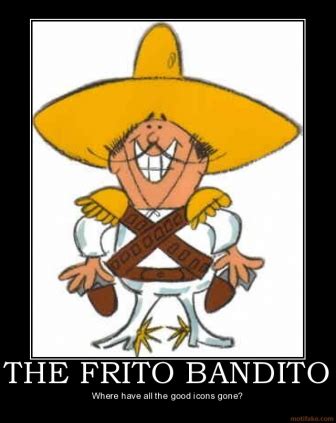Introduction

The Frito Bandito song, a catchy jingle that once graced our airwaves, has left an enduring mark on popular culture. Its familiar melody and memorable lyrics have etched themselves into the memories of generations. But beyond its nostalgic charm, the song has also sparked debates about cultural representation and the legacy of stereotypes in advertising.
The Creation of the Frito Bandito
In the early 1960s, Frito-Lay, a leading snack food company, sought to create a memorable mascot for its tortilla chips brand, Fritos. They turned to advertising agency Foote, Cone & Belding, which developed the character of the Frito Bandito.
The bandito, with his exaggerated sombrero, serape, and thick mustache, was a stereotypical representation of a Mexican outlaw. He spoke with a heavily accented voice and was often portrayed as mischievous and cunning.
The Song’s Popularity and Controversy
The Frito Bandito song, with its infectious tune and playful lyrics, quickly became a hit. It was widely featured in television commercials and radio jingles, and it gained immense popularity among children and adults alike.
However, the song also elicited criticism from some quarters. Critics argued that it perpetuated harmful stereotypes of Mexican-Americans as lazy, untrustworthy, and potentially criminal. They also pointed out that the bandito’s exaggerated accent and appearance reinforced negative perceptions of Mexican culture.
The Song’s Legacy and Cultural Impact
In response to the growing controversy, Frito-Lay retired the Frito Bandito character in 1971. The song, however, continued to be played occasionally until it was officially phased out in the 1990s.
Despite its retirement, the Frito Bandito song remains a potent symbol of the complexities of cultural representation in advertising. It serves as a reminder of the need for sensitivity and respect when portraying different cultures and ethnicities in popular media.
The Bandito’s Redemption
In recent years, there has been a growing movement to redeem the Frito Bandito character. Some scholars and activists have argued that, while the original portrayal was problematic, the bandito can be reinterpreted as a symbol of Mexican-American resilience and humor.
This reinterpretation has found expression in various forms, including artistic installations, academic papers, and even a satirical web series. By reclaiming the Frito Bandito, some argue, Mexican-Americans can challenge negative stereotypes and assert their own cultural narrative.
The Frito Bandito Song: A Case Study in Cultural Representation
The Frito Bandito song provides a fascinating case study in cultural representation. It highlights the challenges of portraying diverse cultures in a way that is both respectful and entertaining. It also underscores the importance of considering the potential impact of advertising on social attitudes and perceptions.
Cultural Sensitivity in Advertising
The Frito Bandito case serves as a valuable lesson for marketers and advertisers today. It emphasizes the need for cultural sensitivity and the importance of avoiding stereotypes that can perpetuate harmful narratives.
In an increasingly globalized world, brands must be mindful of the cultural contexts in which they operate. They must strive to create advertising that is inclusive, respectful, and authentic to the cultures they represent.
Conclusion
The Frito Bandito song is a reminder of the enduring power of advertising and its potential to shape cultural perceptions. While the original jingle may have been problematic, its legacy continues to inspire debates about cultural representation and the importance of sensitivity in marketing and advertising. By learning from the past, we can work towards creating a more inclusive and equitable advertising landscape for the future.
FAQs
-
Why was the Frito Bandito controversial?
– The Frito Bandito was controversial because it reinforced negative stereotypes of Mexican-Americans as lazy, untrustworthy, and potentially criminal. -
When was the Frito Bandito retired?
– The Frito Bandito was retired in 1971. -
What is the legacy of the Frito Bandito song?
– The Frito Bandito song is a reminder of the complexities of cultural representation in advertising and the need for sensitivity when portraying different cultures. -
How can brands avoid perpetuating harmful stereotypes in advertising?
– Brands can avoid perpetuating harmful stereotypes by conducting thorough research, consulting with experts, and seeking feedback from members of the target culture. -
What is the importance of cultural sensitivity in advertising?
– Cultural sensitivity in advertising is important because it helps ensure that brands create inclusive and respectful messages that resonate with target audiences. -
How can we reclaim negative stereotypes in advertising?
– Negative stereotypes in advertising can be reclaimed by recasting them in a positive light, highlighting their underlying cultural significance, or using them as a catalyst for social change.
